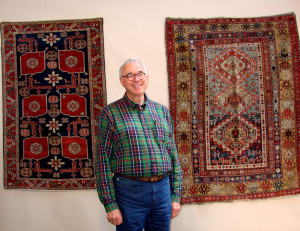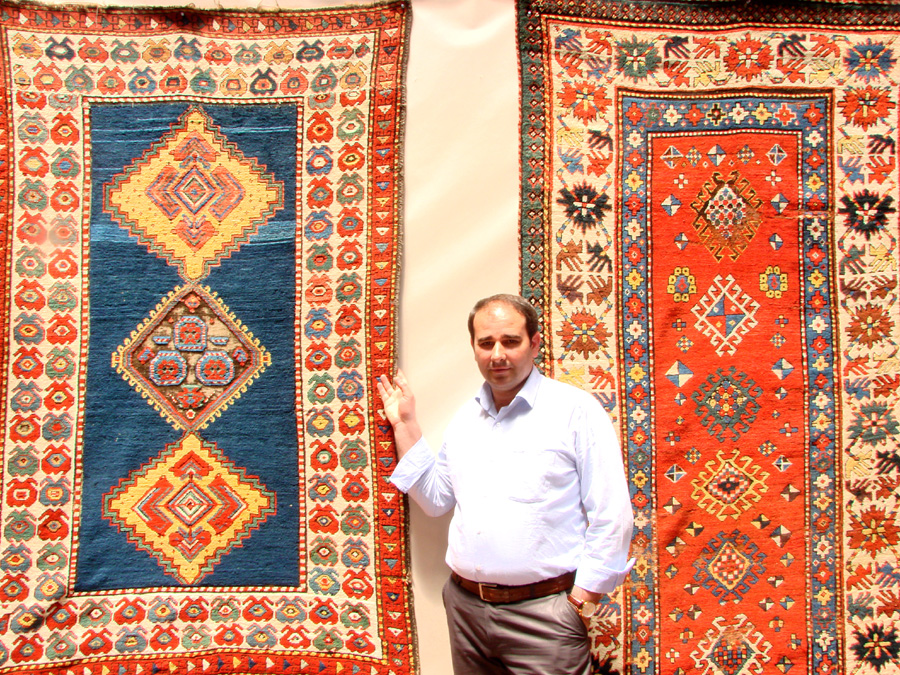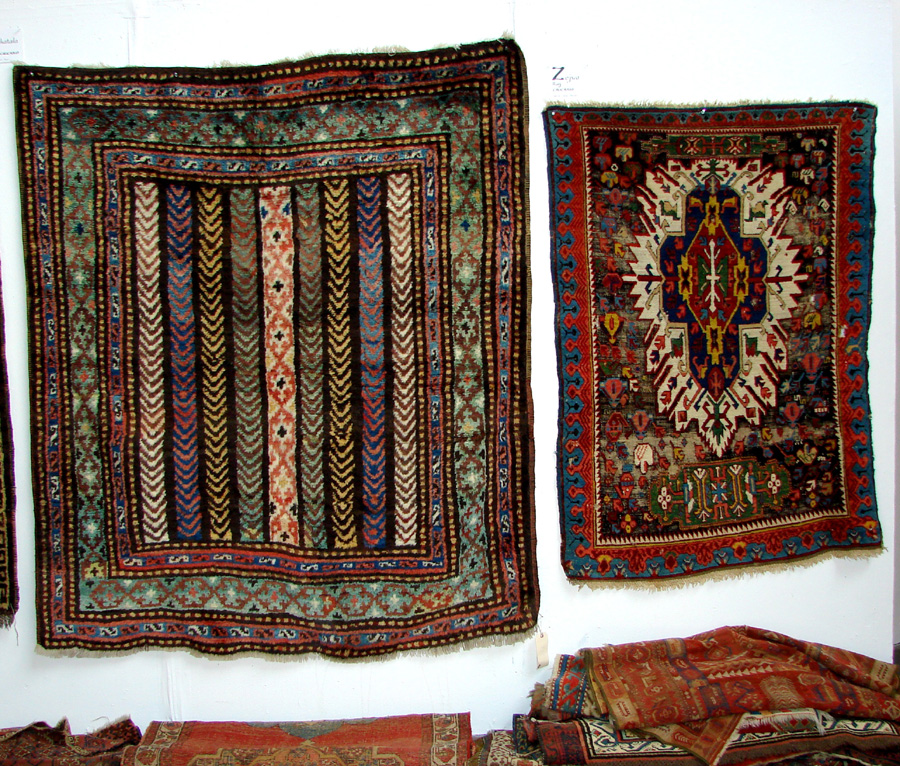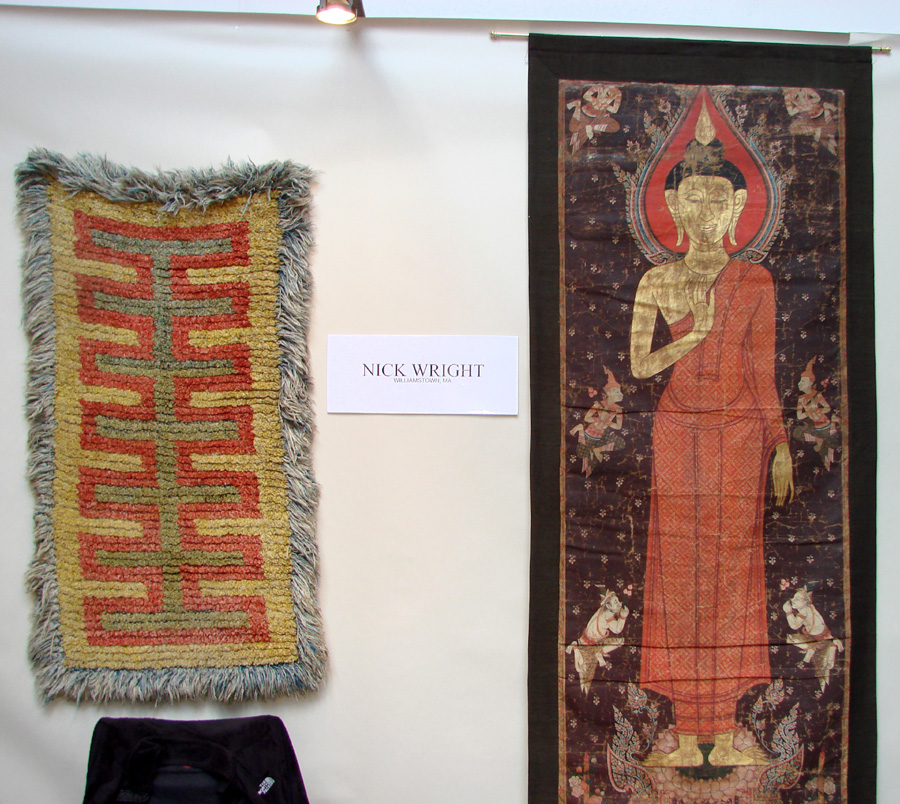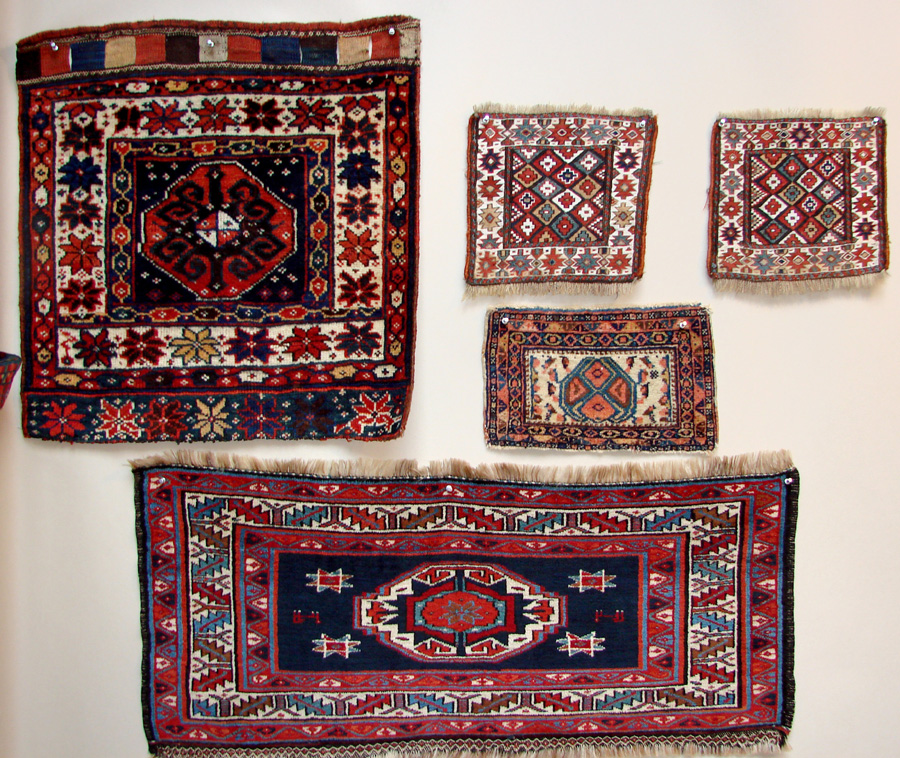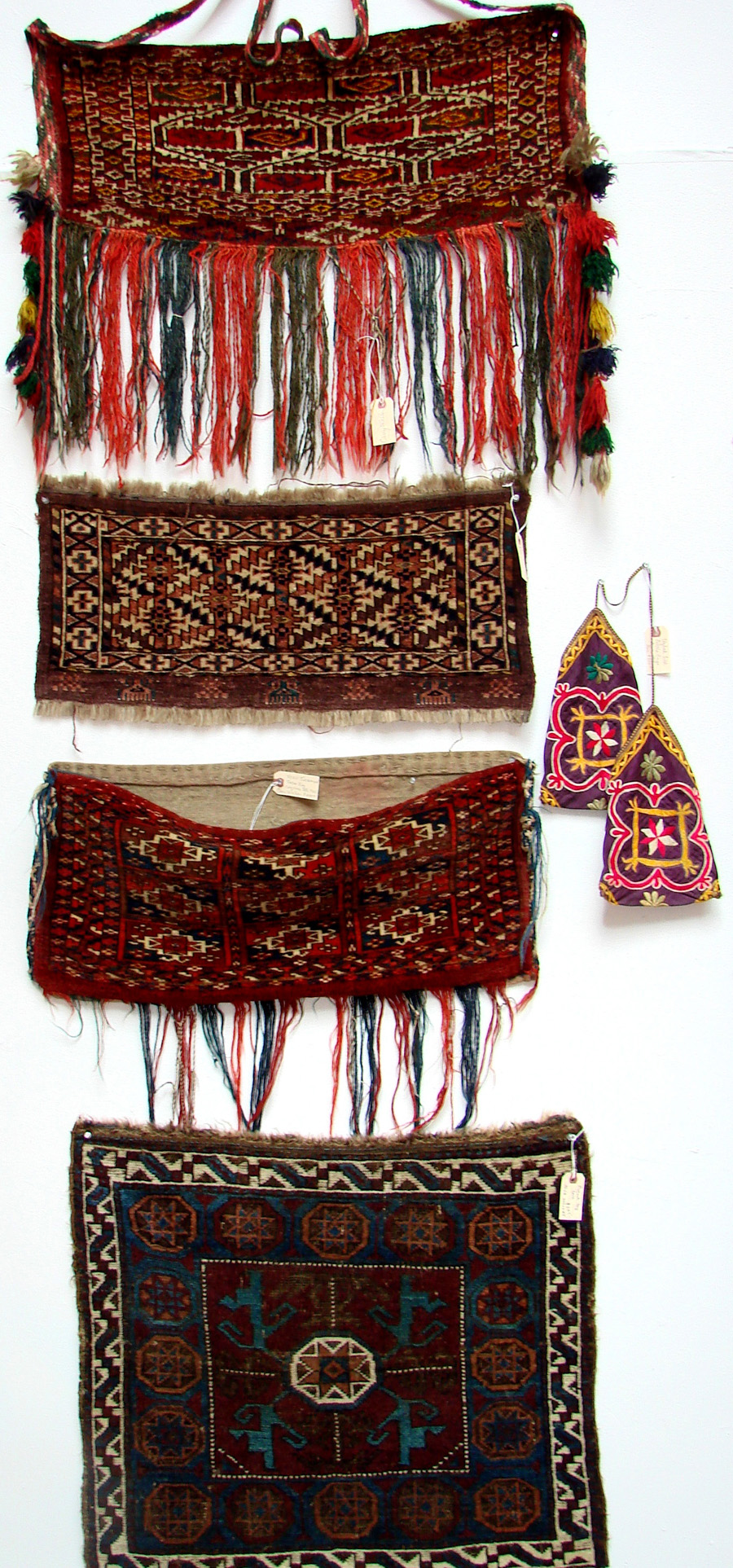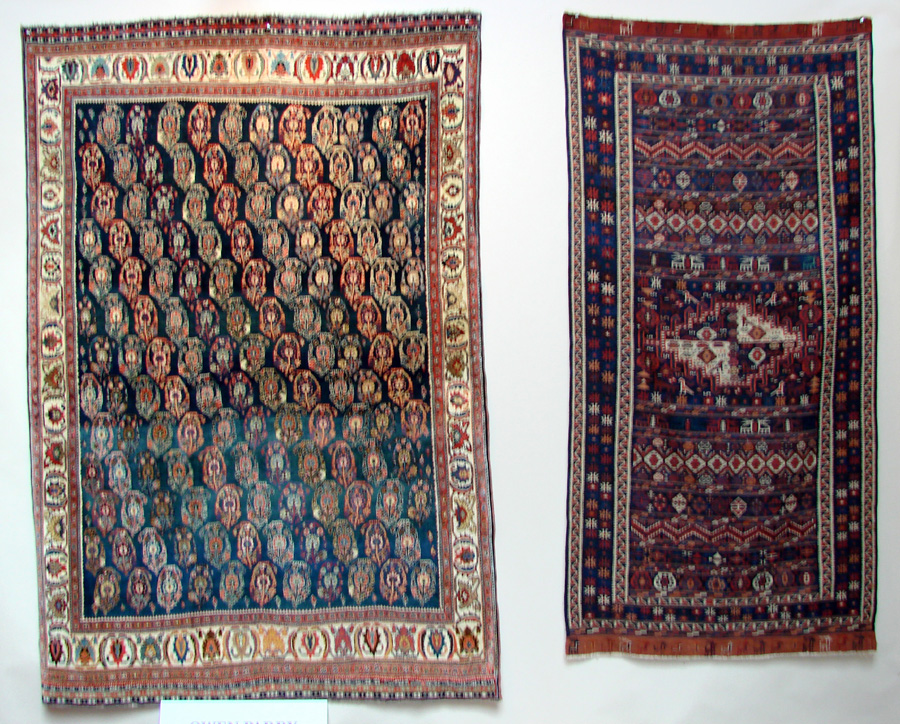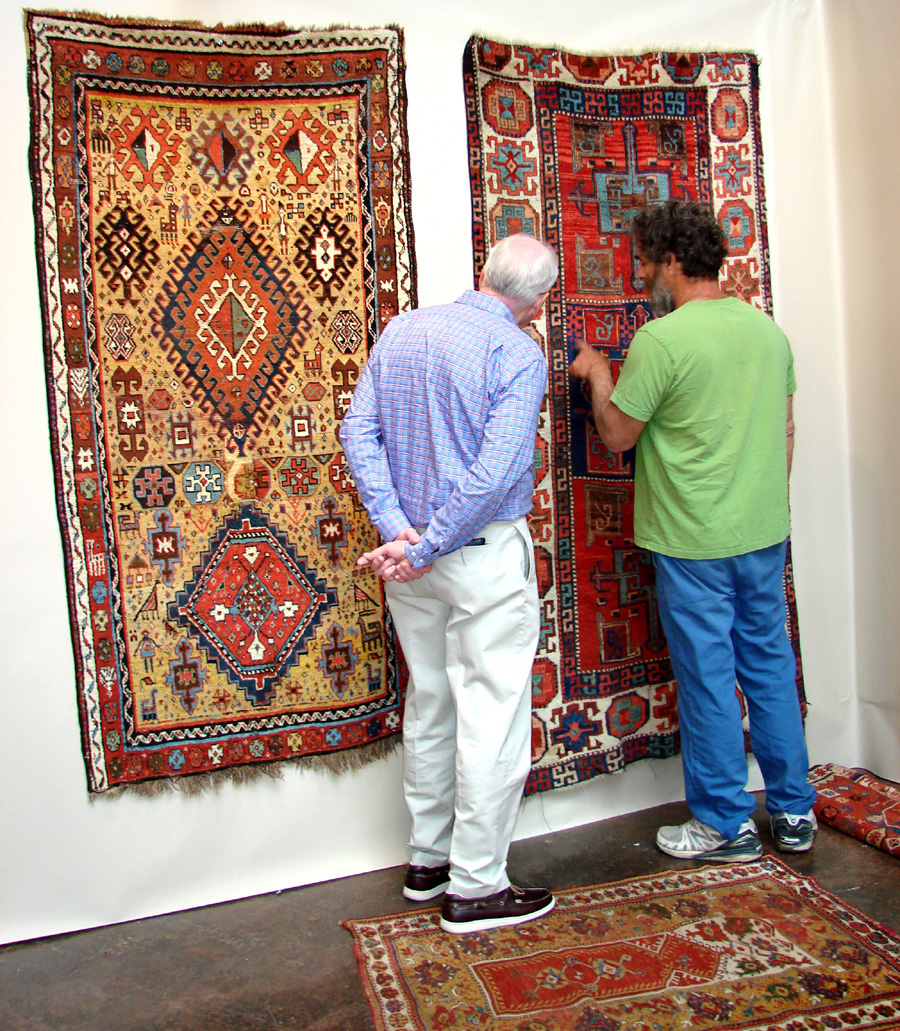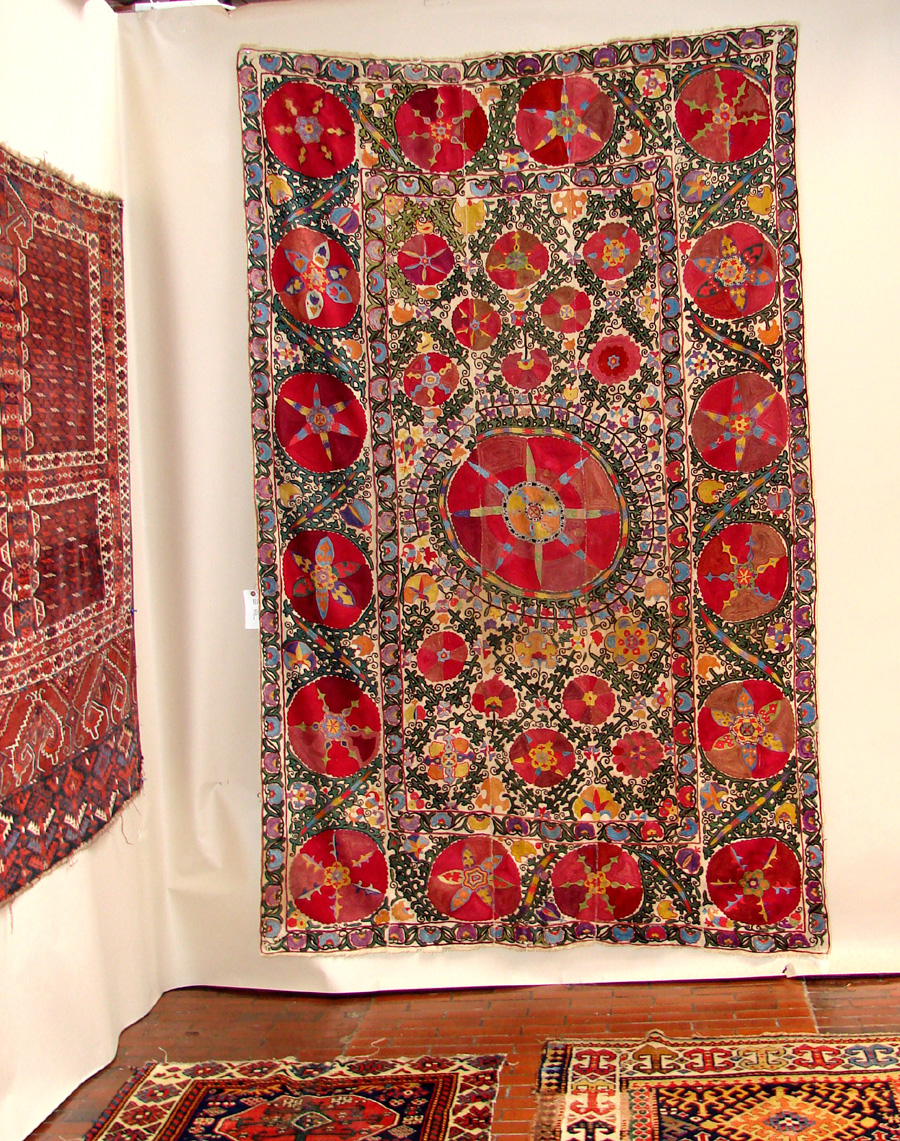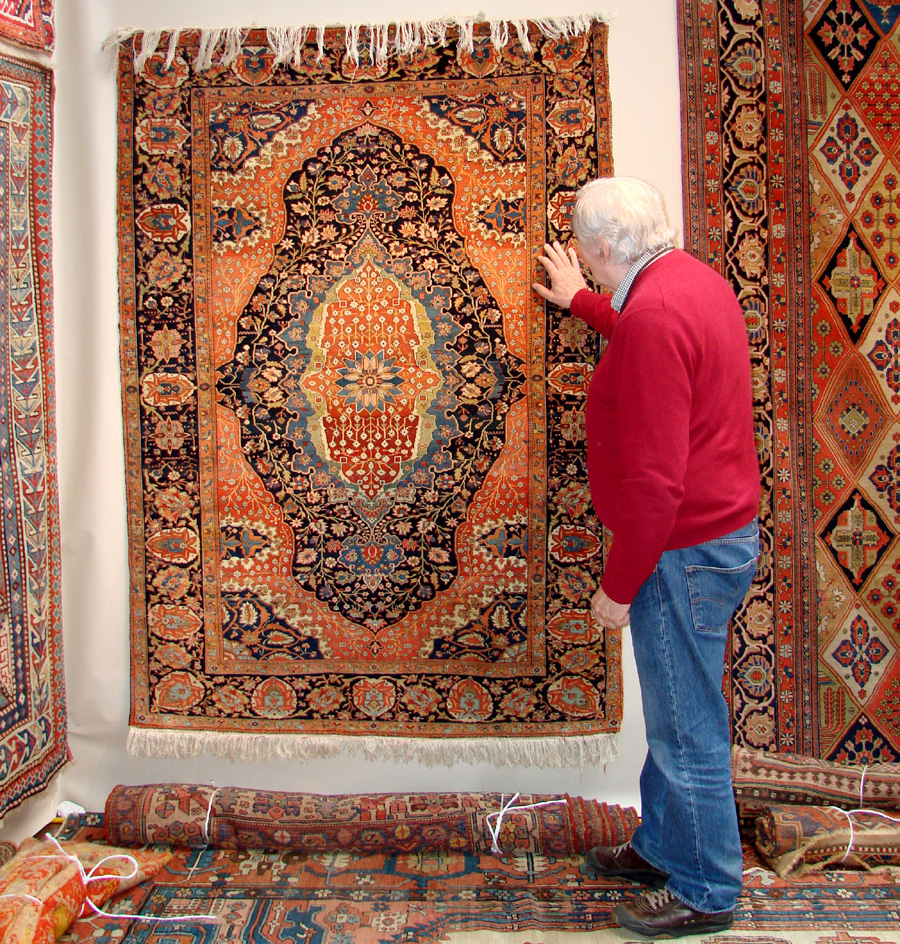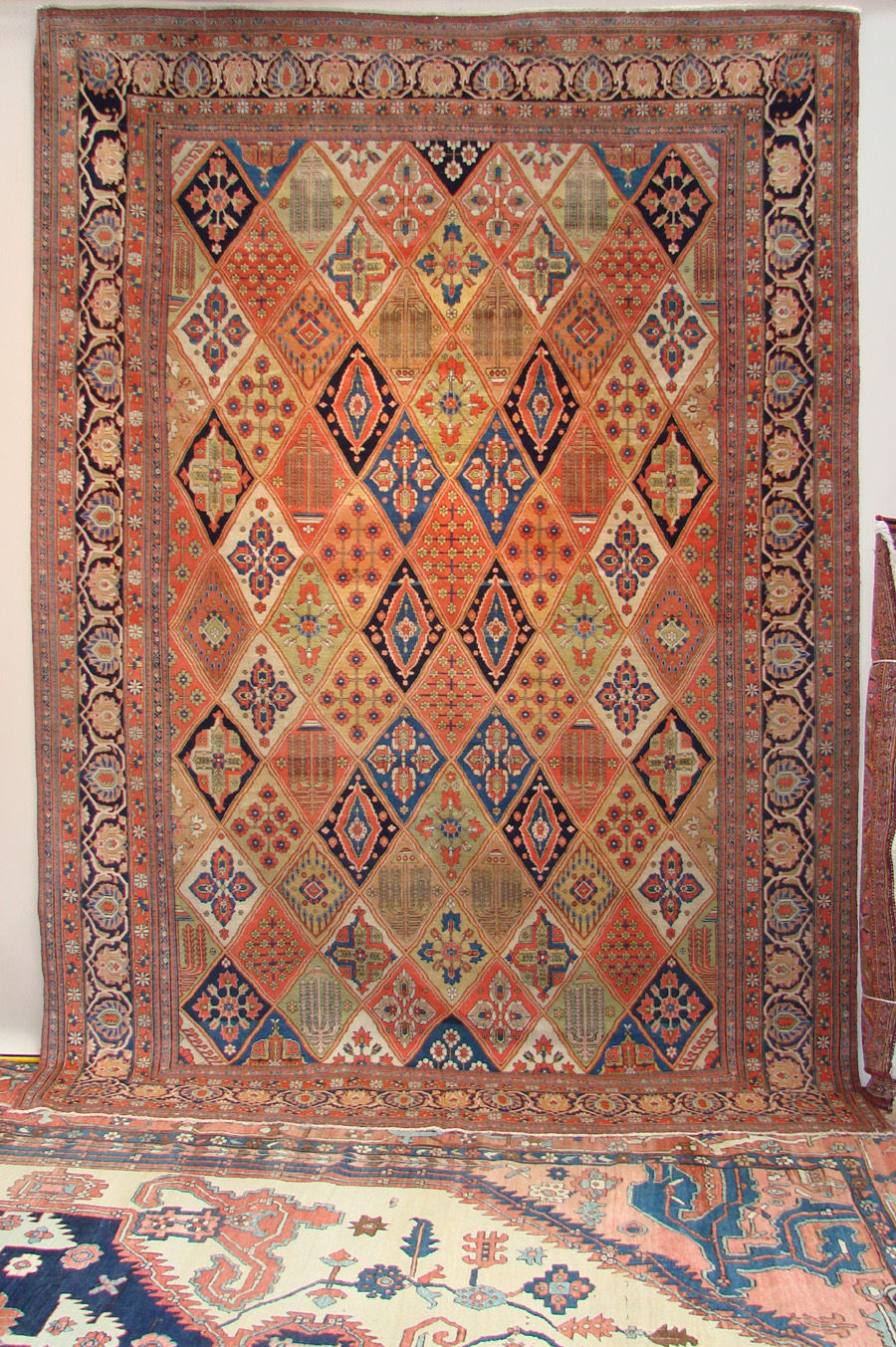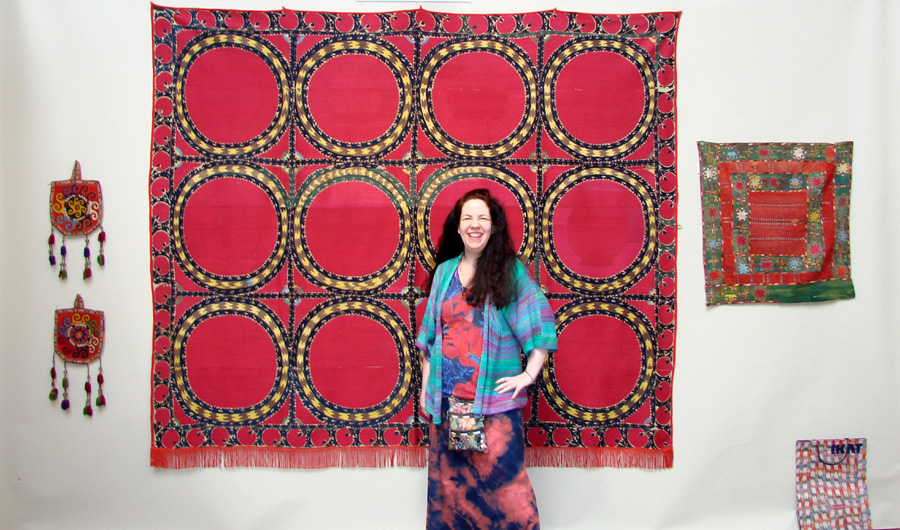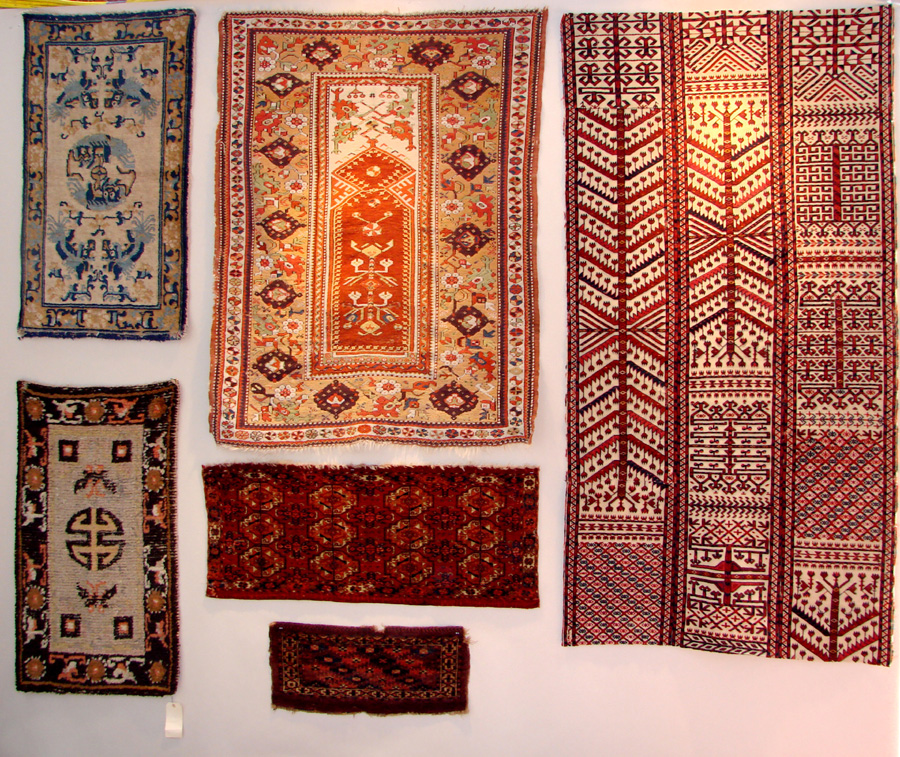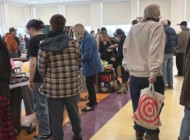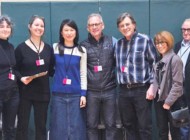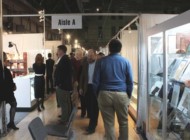Review And Photos by Rick Russack
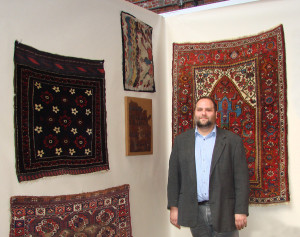
Ben Banayan, San Francisco, is one of the organizers of the show and runs a nonprofit website for rug collectors and dealers at www.rugrabbit.com.
BOSTON, MASS. — Arts East Boston moved its antique rug and textile show into downtown Boston for its second East Coast show June 10–12. The show took over the attractive Cyclorama building, with 24 booths, 26 dealers and an extensive loan exhibit. Adding to the international flavor of the show, dealers came from France, Italy, Turkey, England and Wales, as well as New England, the Midwest and the West Coast. Most had done the show last year, when Michael Grogan, Grogan & Co., allowed event organizers to use his then-recently vacated Dedham auction gallery at no cost. Since Grogan, now with a gallery in Boston, no longer leases the space in Dedham, the organizers wanted to move into Boston proper, so the show came to the Cyclorama.
Ben Banayan, one of the show’s organizers, told Antiques and The Arts Weekly that they would consider the show a success if they attracted 500–1,000 attendees. The show was well advertised and a number of New England dealers were on hand as the show opened. Banayan said that the show was sponsored by the nonprofit Antique Rug and Textile Art Association, whose purpose is to foster interest in Oriental rugs and tribal textile arts.
The organizers of the show were aiming at two markets: rug collectors and first-time rug buyers. In line with their aim to educate buyers, they did several things. Most impressive was the loan exhibit of about 75 rugs from members of the New England Rug Society, an informal group that meets about six times a year. Most rugs were hanging on walls, all were identified and various types were included.
Seminars for new collectors were offered throughout the show, utilizing the loan exhibit. Guided tours of material in dealers’ booths were available and a novel feature was an “under $500 room.” Here, rugs and textiles from exhibitors’ inventory were displayed and priced to encourage first-time buyers. Guidelines for exhibitors noted that most textiles should be “antique” and made with natural, not aniline, dyes. An exception allowed Moroccan rugs and Navajo weavings with chemical dyes.
It was clear from the opening that the show was attracting knowledgeable collectors and dealers. Several familiar faces were on hand for the opening. Most of these buyers said they had attended the show last year and were able to make good buys. Ross Levett, a dealer from Thomaston, Maine, said, “I don’t know where else on the planet a buyer would have a selection of this quality to examine. The stuff is really terrific. I bought some very nice things here last year.”
Numerous small weavings called “bag fronts” were offered. Storage bags were used by nomadic people and were often weavings of high quality and vernacular design. They were hung on tent walls and as saddlebags over camels when traveling. Many, in fact, could be classed as folk art, as they represent a desire to beautify utilitarian, everyday objects. Most bags have a simple burlaplike back piece — the entire bag could have been made of that material but that was not the aim of their makers.
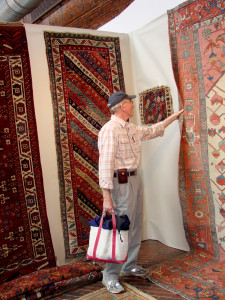
Rug dealer/restorer Tad Runge, Yarmouth, Maine, examines an ivory
field Serapi in the booth
of James Cohen.
The “under $500” section of the show included a number of these bag fronts. Ben Banayan said, “They’re an excellent way for new collectors to get started with quality weavings.” A Baluchi front was priced at $225, a Teke Turkomen with original cloth back was priced at $499 and a small Yomut front was $400. A similar example is currently listed on 1stdibs for nearly seven times this price.
Other inexpensive but quality weavings would include “tent bands,” used when tents were being moved as tribes sought better grazing areas for their livestock.
Banayan explained that the earliest known rug dated to the Fifth Century BCE and he said that a fragment of that rug had been found frozen in Siberia during archeological digs in the 1920s. It is now in the Hermitage Museum in St Petersburg. In the Nineteenth Century, many mosques had outstanding collections of rugs, but most of those rugs are now in museums. One of the most important museum collections, he said, is that of the Vakiflar Museum in Istanbul, Turkey.
Banayan noted that wealthy industrialists like the Rockefellers and Morgans started buying rugs for the mansions they were building in the early Twentieth Century and that many fine rugs were also acquired by wealthy Bostonians. Some of the rugs owned by the Rockefeller family are now in the Metropolitan Museum of Art. If you’re wondering about the high end of the rug market, the record price for a rug at auction was $33.8 million for a Persian carpet at Sotheby’s in 2013. There have also been several other examples of rugs selling for more than $1 million.
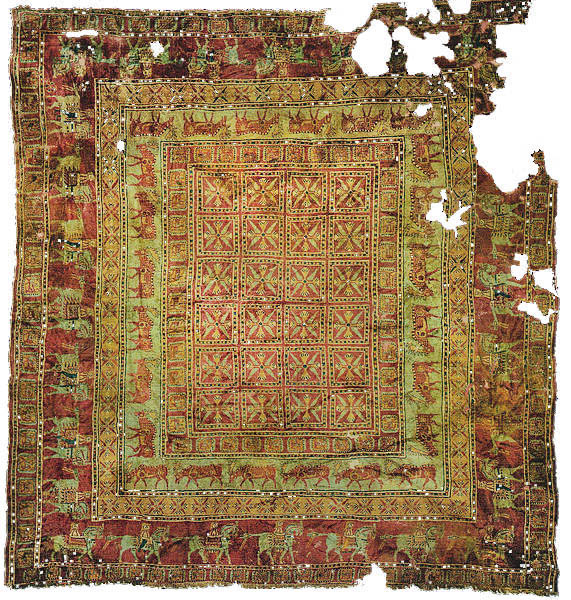
While discussing rugs with Ben Banayan, he mentioned that the “oldest rug in the world” (seen here) dates back to the Fifth Century BCE. It was found frozen in the ground during archeological digs in Siberia in the 1920s. Photo courtesy of Nazmiyal Antique Rugs.
Banayan said the high end of the market has suffered in recent years as two of the major collectors, one of whom was the royal family of Qatar, are not currently actively buying. He also said that many dealers expect Iranians, now that sanctions have been lifted, to enter the marketplace with the intention of bringing fine rugs made in that area back into their country.
There were no million-dollar rugs at this show. One of the more expensive rugs was offered by Doug Stock’s Quadrifoglio Gallery. It was a large, circa 1880, Mohtashem Kashan Persian carpet, priced at $175,000. Carpets woven by master weaver Mohtashem, or the Mohtashem workshop, are considered some of the finest of weavings that have ever been created. Stock commented, “When you consider prices of the very best furniture or art work, rugs of this quality are really undervalued.”
One of the advantages to exhibiting in a show of this type, with dealers from several countries, became apparent while discussing rugs with Stock. Two of the European dealers each said to Stock that they had customers in Europe that might be interested in the rug if it did not sell at this show, which it did not.
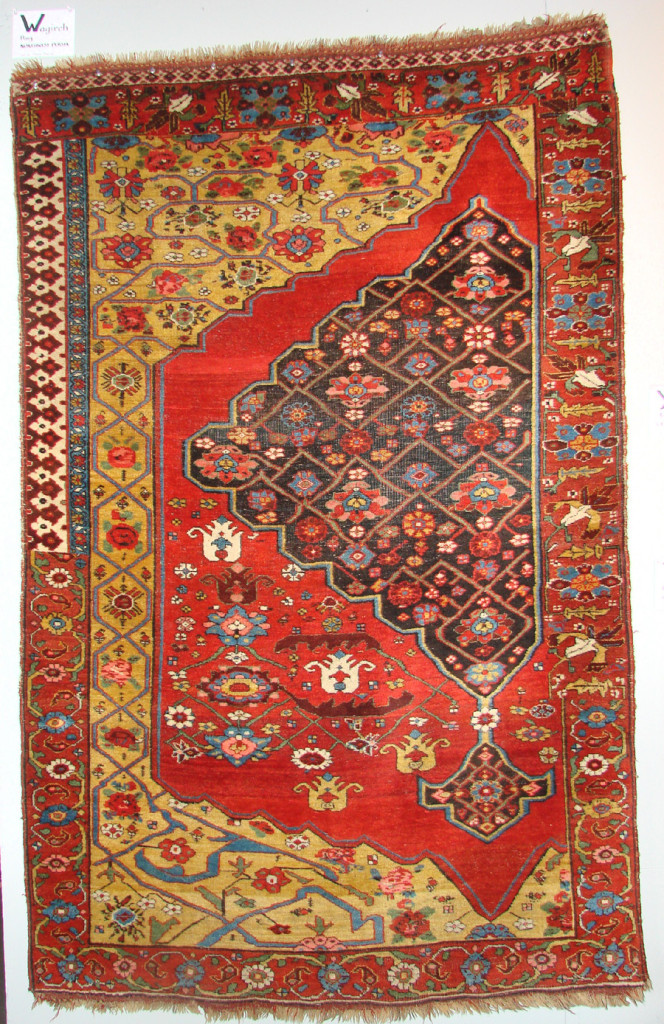
This unusual carpet was part of the loan exhibit. Notice the varying patterns. It was a “sample” rug, used in village workshops to show weavers the various patterns they might be asked to incorporate in their weavings.
Some textiles were done by village women as wedding gifts. A particularly nice example of this type was in the booth of Casey Waller, CaravanSerai, Ltd, Dallas. He offered a Nineteenth Century Tashkent Suzani embroidery, made in central Asia, meant to be hung on a wall. It consisted of six narrow panels, each basically similar, but with minor variations. Waller said that such variations could be the result of each panel being worked by a different woman. He said that this particular piece came from an area with many cherry orchards and some of the designs reflected that origin. Some of the symbolism of these embroideries reflect the religious beliefs of the weavers. It was priced at $8,500. Another example was offered by Alberto Levi, Milan, Italy.
After the show, Wayne Barron, one of the show’s organizers, said that although attendance was light, several dealers said they had had good shows. A Gay Pride parade on the street in front of the Cyclorama building likely had an impact on Saturday’s attendance as driving and parking in the neighborhood were not possible.
“Our objective was to put together a show with quality rugs and knowledgeable dealers. We did that. Since we’re a nonprofit organization, we had limited funds for advertising and we found that the city of Boston had rules and regulations that we had to comply with,” he said. “Last year, when we were at Grogan’s building in Dedham, we were able to offer wine and liquor to attendees, but we couldn’t do that here. We also wanted to hang a large banner on the front of the building, announcing the show, but we couldn’t do that without getting a permit, etc. If we do a repeat in Boston, we’ll have a better idea of what we have to do.”
For anyone who missed the show, a nice photo gallery of its exhibiting dealers and a few of their offerings is available at www.artsrugshow.org. For more information, contact Wayne Barron at 617-710-2187.

